Report on Management Accounting Principles for Imda Tech (UK) Limited
VerifiedAdded on 2020/02/05
|13
|4203
|260
Report
AI Summary
This report provides a comprehensive analysis of management accounting principles, focusing on Imda Tech (UK) Limited. It begins by defining management accounting and contrasting it with financial accounting, highlighting its importance in decision-making. The report then delves into different management accounting systems, including cost accounting, inventory management, and job costing systems. It explores absorption costing and marginal costing methods, comparing their impact on profitability. Furthermore, the report examines various types of budgets, their advantages, and disadvantages, as well as the budgeting process. The report also covers the Balance Scorecard and its implementation for performance measurement. The report uses the case study of Imda Tech to illustrate the application of these concepts, analyzing financial problems and improvement strategies for effective financial management. The report provides a detailed overview of costing, budgeting, and decision-making tools within a business context.
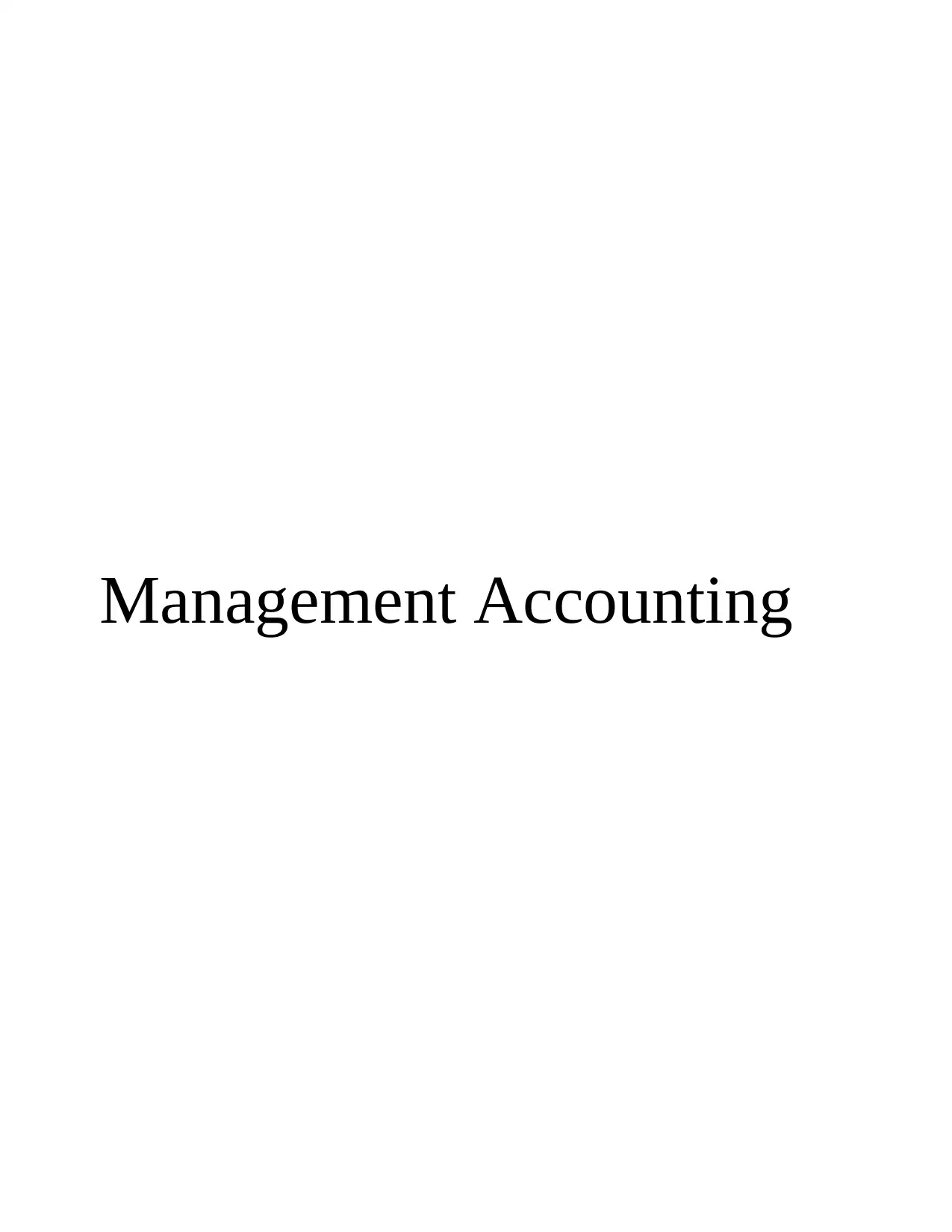
Management Accounting
Paraphrase This Document
Need a fresh take? Get an instant paraphrase of this document with our AI Paraphraser

Table of Contents
INTRODUCTION........................................................................................................................................3
TASK 1.........................................................................................................................................................3
a) Definition of management accounting and difference between management accounting from
financial accounting.................................................................................................................................3
b) Importance of management accounting information as a decision making tool.................................5
c) Types of management accounting system...........................................................................................5
TASK 2 ........................................................................................................................................................6
1. Absorption Costing..............................................................................................................................6
2. Marginal Costing Method....................................................................................................................7
TASK 3.........................................................................................................................................................8
a) Types of budget and there advantage/ disadvantages..........................................................................8
b) Process of preparing budgets...............................................................................................................9
TASK 4.......................................................................................................................................................10
1. Explain balance scorecard and how it can be implemented can deliver a range of performance
measure..................................................................................................................................................10
CONCLUSION..........................................................................................................................................11
REFERENCES...........................................................................................................................................12
INTRODUCTION........................................................................................................................................3
TASK 1.........................................................................................................................................................3
a) Definition of management accounting and difference between management accounting from
financial accounting.................................................................................................................................3
b) Importance of management accounting information as a decision making tool.................................5
c) Types of management accounting system...........................................................................................5
TASK 2 ........................................................................................................................................................6
1. Absorption Costing..............................................................................................................................6
2. Marginal Costing Method....................................................................................................................7
TASK 3.........................................................................................................................................................8
a) Types of budget and there advantage/ disadvantages..........................................................................8
b) Process of preparing budgets...............................................................................................................9
TASK 4.......................................................................................................................................................10
1. Explain balance scorecard and how it can be implemented can deliver a range of performance
measure..................................................................................................................................................10
CONCLUSION..........................................................................................................................................11
REFERENCES...........................................................................................................................................12
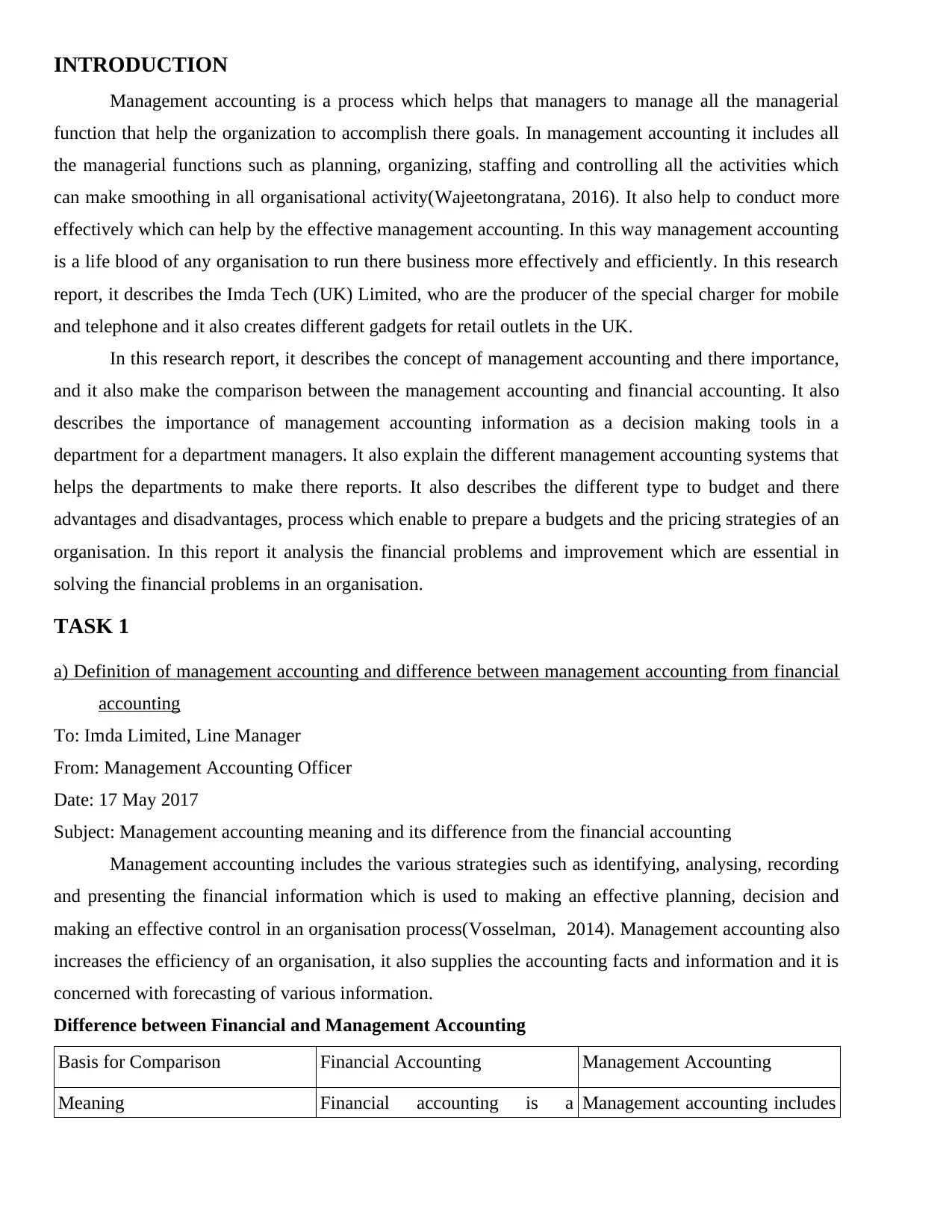
INTRODUCTION
Management accounting is a process which helps that managers to manage all the managerial
function that help the organization to accomplish there goals. In management accounting it includes all
the managerial functions such as planning, organizing, staffing and controlling all the activities which
can make smoothing in all organisational activity(Wajeetongratana, 2016). It also help to conduct more
effectively which can help by the effective management accounting. In this way management accounting
is a life blood of any organisation to run there business more effectively and efficiently. In this research
report, it describes the Imda Tech (UK) Limited, who are the producer of the special charger for mobile
and telephone and it also creates different gadgets for retail outlets in the UK.
In this research report, it describes the concept of management accounting and there importance,
and it also make the comparison between the management accounting and financial accounting. It also
describes the importance of management accounting information as a decision making tools in a
department for a department managers. It also explain the different management accounting systems that
helps the departments to make there reports. It also describes the different type to budget and there
advantages and disadvantages, process which enable to prepare a budgets and the pricing strategies of an
organisation. In this report it analysis the financial problems and improvement which are essential in
solving the financial problems in an organisation.
TASK 1
a) Definition of management accounting and difference between management accounting from financial
accounting
To: Imda Limited, Line Manager
From: Management Accounting Officer
Date: 17 May 2017
Subject: Management accounting meaning and its difference from the financial accounting
Management accounting includes the various strategies such as identifying, analysing, recording
and presenting the financial information which is used to making an effective planning, decision and
making an effective control in an organisation process(Vosselman, 2014). Management accounting also
increases the efficiency of an organisation, it also supplies the accounting facts and information and it is
concerned with forecasting of various information.
Difference between Financial and Management Accounting
Basis for Comparison Financial Accounting Management Accounting
Meaning Financial accounting is a Management accounting includes
Management accounting is a process which helps that managers to manage all the managerial
function that help the organization to accomplish there goals. In management accounting it includes all
the managerial functions such as planning, organizing, staffing and controlling all the activities which
can make smoothing in all organisational activity(Wajeetongratana, 2016). It also help to conduct more
effectively which can help by the effective management accounting. In this way management accounting
is a life blood of any organisation to run there business more effectively and efficiently. In this research
report, it describes the Imda Tech (UK) Limited, who are the producer of the special charger for mobile
and telephone and it also creates different gadgets for retail outlets in the UK.
In this research report, it describes the concept of management accounting and there importance,
and it also make the comparison between the management accounting and financial accounting. It also
describes the importance of management accounting information as a decision making tools in a
department for a department managers. It also explain the different management accounting systems that
helps the departments to make there reports. It also describes the different type to budget and there
advantages and disadvantages, process which enable to prepare a budgets and the pricing strategies of an
organisation. In this report it analysis the financial problems and improvement which are essential in
solving the financial problems in an organisation.
TASK 1
a) Definition of management accounting and difference between management accounting from financial
accounting
To: Imda Limited, Line Manager
From: Management Accounting Officer
Date: 17 May 2017
Subject: Management accounting meaning and its difference from the financial accounting
Management accounting includes the various strategies such as identifying, analysing, recording
and presenting the financial information which is used to making an effective planning, decision and
making an effective control in an organisation process(Vosselman, 2014). Management accounting also
increases the efficiency of an organisation, it also supplies the accounting facts and information and it is
concerned with forecasting of various information.
Difference between Financial and Management Accounting
Basis for Comparison Financial Accounting Management Accounting
Meaning Financial accounting is a Management accounting includes
⊘ This is a preview!⊘
Do you want full access?
Subscribe today to unlock all pages.

Trusted by 1+ million students worldwide
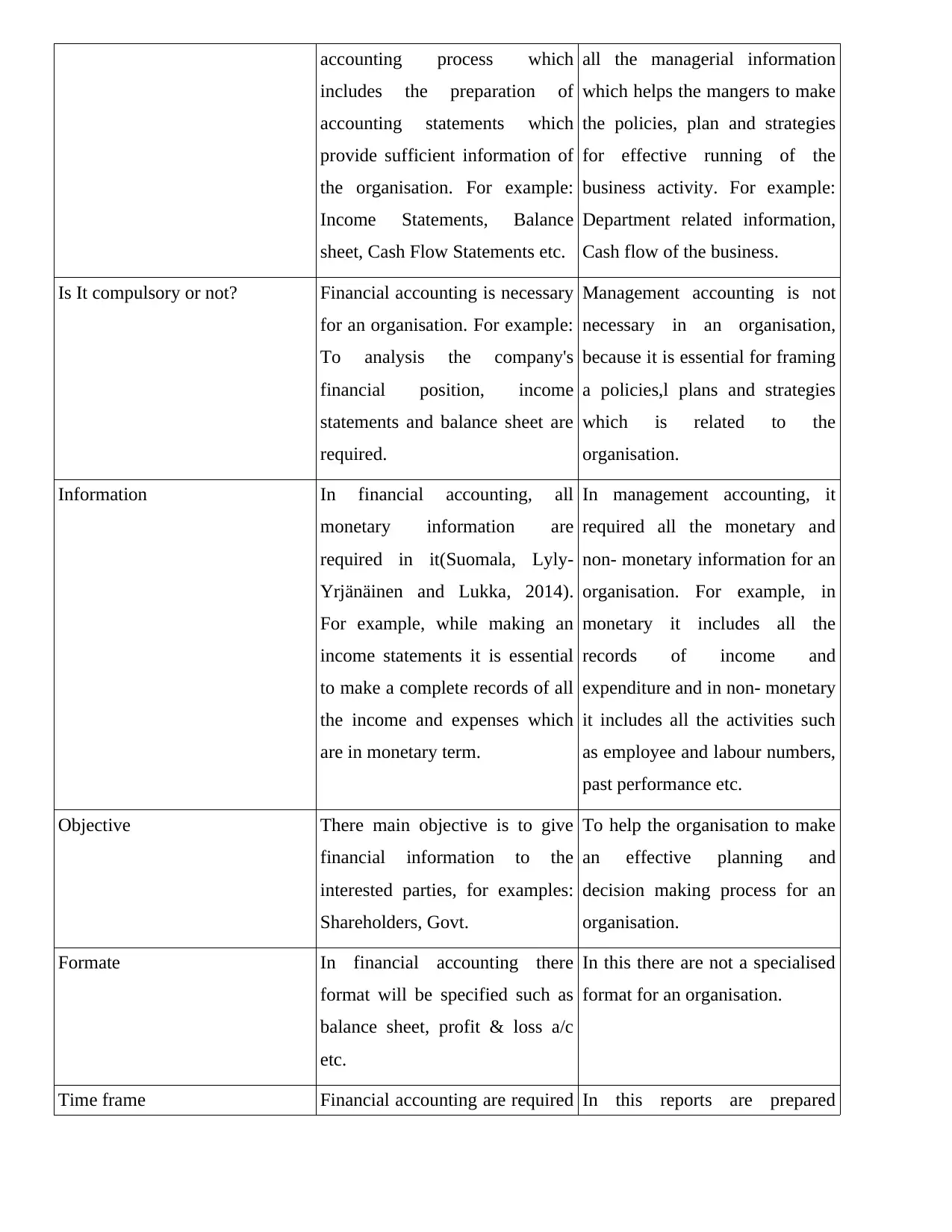
accounting process which
includes the preparation of
accounting statements which
provide sufficient information of
the organisation. For example:
Income Statements, Balance
sheet, Cash Flow Statements etc.
all the managerial information
which helps the mangers to make
the policies, plan and strategies
for effective running of the
business activity. For example:
Department related information,
Cash flow of the business.
Is It compulsory or not? Financial accounting is necessary
for an organisation. For example:
To analysis the company's
financial position, income
statements and balance sheet are
required.
Management accounting is not
necessary in an organisation,
because it is essential for framing
a policies,l plans and strategies
which is related to the
organisation.
Information In financial accounting, all
monetary information are
required in it(Suomala, Lyly-
Yrjänäinen and Lukka, 2014).
For example, while making an
income statements it is essential
to make a complete records of all
the income and expenses which
are in monetary term.
In management accounting, it
required all the monetary and
non- monetary information for an
organisation. For example, in
monetary it includes all the
records of income and
expenditure and in non- monetary
it includes all the activities such
as employee and labour numbers,
past performance etc.
Objective There main objective is to give
financial information to the
interested parties, for examples:
Shareholders, Govt.
To help the organisation to make
an effective planning and
decision making process for an
organisation.
Formate In financial accounting there
format will be specified such as
balance sheet, profit & loss a/c
etc.
In this there are not a specialised
format for an organisation.
Time frame Financial accounting are required In this reports are prepared
includes the preparation of
accounting statements which
provide sufficient information of
the organisation. For example:
Income Statements, Balance
sheet, Cash Flow Statements etc.
all the managerial information
which helps the mangers to make
the policies, plan and strategies
for effective running of the
business activity. For example:
Department related information,
Cash flow of the business.
Is It compulsory or not? Financial accounting is necessary
for an organisation. For example:
To analysis the company's
financial position, income
statements and balance sheet are
required.
Management accounting is not
necessary in an organisation,
because it is essential for framing
a policies,l plans and strategies
which is related to the
organisation.
Information In financial accounting, all
monetary information are
required in it(Suomala, Lyly-
Yrjänäinen and Lukka, 2014).
For example, while making an
income statements it is essential
to make a complete records of all
the income and expenses which
are in monetary term.
In management accounting, it
required all the monetary and
non- monetary information for an
organisation. For example, in
monetary it includes all the
records of income and
expenditure and in non- monetary
it includes all the activities such
as employee and labour numbers,
past performance etc.
Objective There main objective is to give
financial information to the
interested parties, for examples:
Shareholders, Govt.
To help the organisation to make
an effective planning and
decision making process for an
organisation.
Formate In financial accounting there
format will be specified such as
balance sheet, profit & loss a/c
etc.
In this there are not a specialised
format for an organisation.
Time frame Financial accounting are required In this reports are prepared
Paraphrase This Document
Need a fresh take? Get an instant paraphrase of this document with our AI Paraphraser

at the end of the accounting
period. For example: 1 April to
31 March.
whenever there will be the need
of an organisation.
Users Financial accounting can be used
by external and outsiders parties
such as shareholders, managers,
Govt., investors etc.
Management Accounting is done
by only internal management of
an organisation.
Publishing and auditing Financial accounting need to be
published and audited by
statutory auditors.
But in management accounting it
are not required to make any
publication and auditing by the
statutory auditors.
b) Importance of management accounting information as a decision making tool
Management accounting is essential for decision-making process of an organisation. It is an
important tool for the department mangers to take a decision because through management accounting it
helps to analysis the relevant cost in an organisation. In other words, in management accounting it helps
the managers to examined or determined that what should be buy and sold in an organisation(Tappura,
Sievänen, Heikkilä, Jussila and Nenonen, 2015). In this case, IMDA's owner ensure to make an effective
marketing strategies that help to promote there products but in a effective cost manner.
When an organisation is decide what products are to be buy and sell that department mangers
should adopt an effective costing techniques so that it can minimize the cost and maximizer the
organisation's profitability. In this management accounting helps to the department mangers to make an
activity- based costing techniques which focuses in customers and profitability too.
Management accounting provides data which is related to organization's operational activity. So
that it will help the department managers to utilize the data effectively. For example, in Imda ltd.,
department mangers should focus on data which are used in making appropriate budget of the company,
so that company can manage there funds for there manufacturing activities. In this way management
accounting is a effective tool of making decision and also make the strategic planning. As a tool of
decision making it include to examine the ratio, financial position of the company, and also help to
forecasting in budget such as cash flow and there different variances which is related to the Imda
limited.
period. For example: 1 April to
31 March.
whenever there will be the need
of an organisation.
Users Financial accounting can be used
by external and outsiders parties
such as shareholders, managers,
Govt., investors etc.
Management Accounting is done
by only internal management of
an organisation.
Publishing and auditing Financial accounting need to be
published and audited by
statutory auditors.
But in management accounting it
are not required to make any
publication and auditing by the
statutory auditors.
b) Importance of management accounting information as a decision making tool
Management accounting is essential for decision-making process of an organisation. It is an
important tool for the department mangers to take a decision because through management accounting it
helps to analysis the relevant cost in an organisation. In other words, in management accounting it helps
the managers to examined or determined that what should be buy and sold in an organisation(Tappura,
Sievänen, Heikkilä, Jussila and Nenonen, 2015). In this case, IMDA's owner ensure to make an effective
marketing strategies that help to promote there products but in a effective cost manner.
When an organisation is decide what products are to be buy and sell that department mangers
should adopt an effective costing techniques so that it can minimize the cost and maximizer the
organisation's profitability. In this management accounting helps to the department mangers to make an
activity- based costing techniques which focuses in customers and profitability too.
Management accounting provides data which is related to organization's operational activity. So
that it will help the department managers to utilize the data effectively. For example, in Imda ltd.,
department mangers should focus on data which are used in making appropriate budget of the company,
so that company can manage there funds for there manufacturing activities. In this way management
accounting is a effective tool of making decision and also make the strategic planning. As a tool of
decision making it include to examine the ratio, financial position of the company, and also help to
forecasting in budget such as cash flow and there different variances which is related to the Imda
limited.
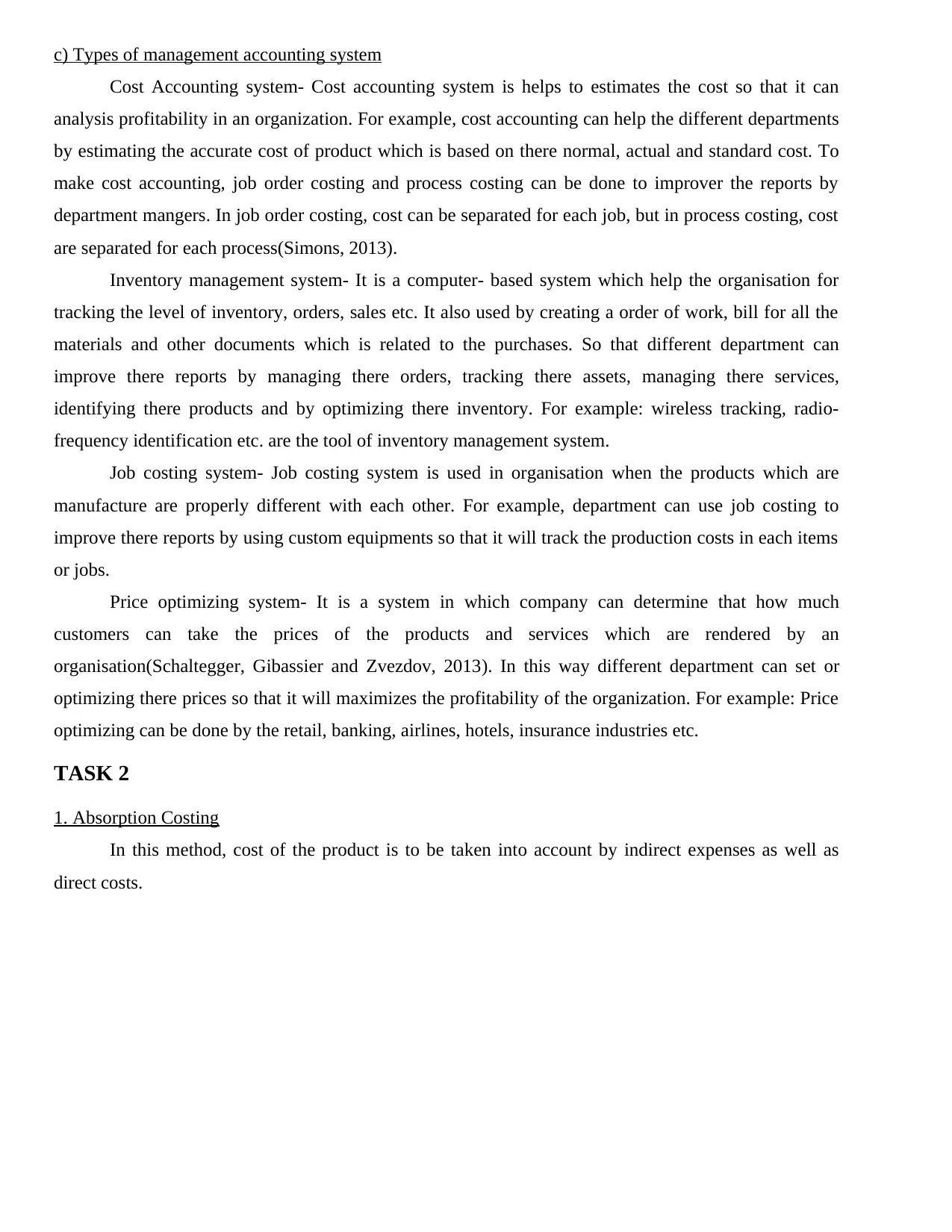
c) Types of management accounting system
Cost Accounting system- Cost accounting system is helps to estimates the cost so that it can
analysis profitability in an organization. For example, cost accounting can help the different departments
by estimating the accurate cost of product which is based on there normal, actual and standard cost. To
make cost accounting, job order costing and process costing can be done to improver the reports by
department mangers. In job order costing, cost can be separated for each job, but in process costing, cost
are separated for each process(Simons, 2013).
Inventory management system- It is a computer- based system which help the organisation for
tracking the level of inventory, orders, sales etc. It also used by creating a order of work, bill for all the
materials and other documents which is related to the purchases. So that different department can
improve there reports by managing there orders, tracking there assets, managing there services,
identifying there products and by optimizing there inventory. For example: wireless tracking, radio-
frequency identification etc. are the tool of inventory management system.
Job costing system- Job costing system is used in organisation when the products which are
manufacture are properly different with each other. For example, department can use job costing to
improve there reports by using custom equipments so that it will track the production costs in each items
or jobs.
Price optimizing system- It is a system in which company can determine that how much
customers can take the prices of the products and services which are rendered by an
organisation(Schaltegger, Gibassier and Zvezdov, 2013). In this way different department can set or
optimizing there prices so that it will maximizes the profitability of the organization. For example: Price
optimizing can be done by the retail, banking, airlines, hotels, insurance industries etc.
TASK 2
1. Absorption Costing
In this method, cost of the product is to be taken into account by indirect expenses as well as
direct costs.
Cost Accounting system- Cost accounting system is helps to estimates the cost so that it can
analysis profitability in an organization. For example, cost accounting can help the different departments
by estimating the accurate cost of product which is based on there normal, actual and standard cost. To
make cost accounting, job order costing and process costing can be done to improver the reports by
department mangers. In job order costing, cost can be separated for each job, but in process costing, cost
are separated for each process(Simons, 2013).
Inventory management system- It is a computer- based system which help the organisation for
tracking the level of inventory, orders, sales etc. It also used by creating a order of work, bill for all the
materials and other documents which is related to the purchases. So that different department can
improve there reports by managing there orders, tracking there assets, managing there services,
identifying there products and by optimizing there inventory. For example: wireless tracking, radio-
frequency identification etc. are the tool of inventory management system.
Job costing system- Job costing system is used in organisation when the products which are
manufacture are properly different with each other. For example, department can use job costing to
improve there reports by using custom equipments so that it will track the production costs in each items
or jobs.
Price optimizing system- It is a system in which company can determine that how much
customers can take the prices of the products and services which are rendered by an
organisation(Schaltegger, Gibassier and Zvezdov, 2013). In this way different department can set or
optimizing there prices so that it will maximizes the profitability of the organization. For example: Price
optimizing can be done by the retail, banking, airlines, hotels, insurance industries etc.
TASK 2
1. Absorption Costing
In this method, cost of the product is to be taken into account by indirect expenses as well as
direct costs.
⊘ This is a preview!⊘
Do you want full access?
Subscribe today to unlock all pages.

Trusted by 1+ million students worldwide

In this solution sales is 1500 unit and per unit cost is 35 so that amount is 52500, direct material
is 16000, direct labour is 10000, overheads is 4000(variable), fixed overhead is 10000, GP is 12500 and
there fixed and variable expenditure is 10000 and 7875, so that there net loss is -5375 by using
absorption costing.
2. Marginal Costing Method
It is a management costing method that can be used by the company for the purpose of preparing
the income statement in the financial year. Thus, it can be define in terms of management accounting is
that there is an increment and decrement in an opportunity cost of a firm when there is an extra unit of
cost produce at each production level(Renz, 2016).
is 16000, direct labour is 10000, overheads is 4000(variable), fixed overhead is 10000, GP is 12500 and
there fixed and variable expenditure is 10000 and 7875, so that there net loss is -5375 by using
absorption costing.
2. Marginal Costing Method
It is a management costing method that can be used by the company for the purpose of preparing
the income statement in the financial year. Thus, it can be define in terms of management accounting is
that there is an increment and decrement in an opportunity cost of a firm when there is an extra unit of
cost produce at each production level(Renz, 2016).
Paraphrase This Document
Need a fresh take? Get an instant paraphrase of this document with our AI Paraphraser
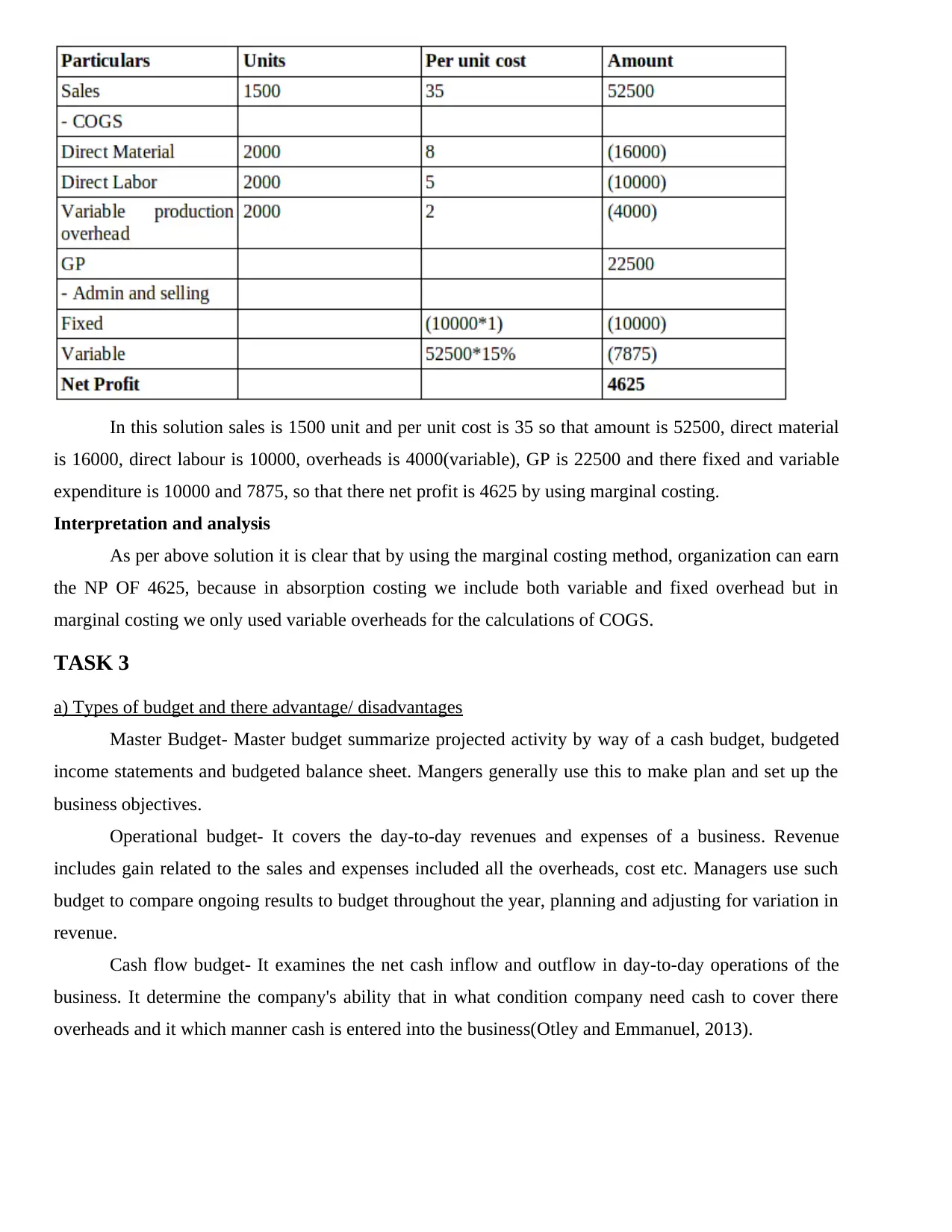
In this solution sales is 1500 unit and per unit cost is 35 so that amount is 52500, direct material
is 16000, direct labour is 10000, overheads is 4000(variable), GP is 22500 and there fixed and variable
expenditure is 10000 and 7875, so that there net profit is 4625 by using marginal costing.
Interpretation and analysis
As per above solution it is clear that by using the marginal costing method, organization can earn
the NP OF 4625, because in absorption costing we include both variable and fixed overhead but in
marginal costing we only used variable overheads for the calculations of COGS.
TASK 3
a) Types of budget and there advantage/ disadvantages
Master Budget- Master budget summarize projected activity by way of a cash budget, budgeted
income statements and budgeted balance sheet. Mangers generally use this to make plan and set up the
business objectives.
Operational budget- It covers the day-to-day revenues and expenses of a business. Revenue
includes gain related to the sales and expenses included all the overheads, cost etc. Managers use such
budget to compare ongoing results to budget throughout the year, planning and adjusting for variation in
revenue.
Cash flow budget- It examines the net cash inflow and outflow in day-to-day operations of the
business. It determine the company's ability that in what condition company need cash to cover there
overheads and it which manner cash is entered into the business(Otley and Emmanuel, 2013).
is 16000, direct labour is 10000, overheads is 4000(variable), GP is 22500 and there fixed and variable
expenditure is 10000 and 7875, so that there net profit is 4625 by using marginal costing.
Interpretation and analysis
As per above solution it is clear that by using the marginal costing method, organization can earn
the NP OF 4625, because in absorption costing we include both variable and fixed overhead but in
marginal costing we only used variable overheads for the calculations of COGS.
TASK 3
a) Types of budget and there advantage/ disadvantages
Master Budget- Master budget summarize projected activity by way of a cash budget, budgeted
income statements and budgeted balance sheet. Mangers generally use this to make plan and set up the
business objectives.
Operational budget- It covers the day-to-day revenues and expenses of a business. Revenue
includes gain related to the sales and expenses included all the overheads, cost etc. Managers use such
budget to compare ongoing results to budget throughout the year, planning and adjusting for variation in
revenue.
Cash flow budget- It examines the net cash inflow and outflow in day-to-day operations of the
business. It determine the company's ability that in what condition company need cash to cover there
overheads and it which manner cash is entered into the business(Otley and Emmanuel, 2013).
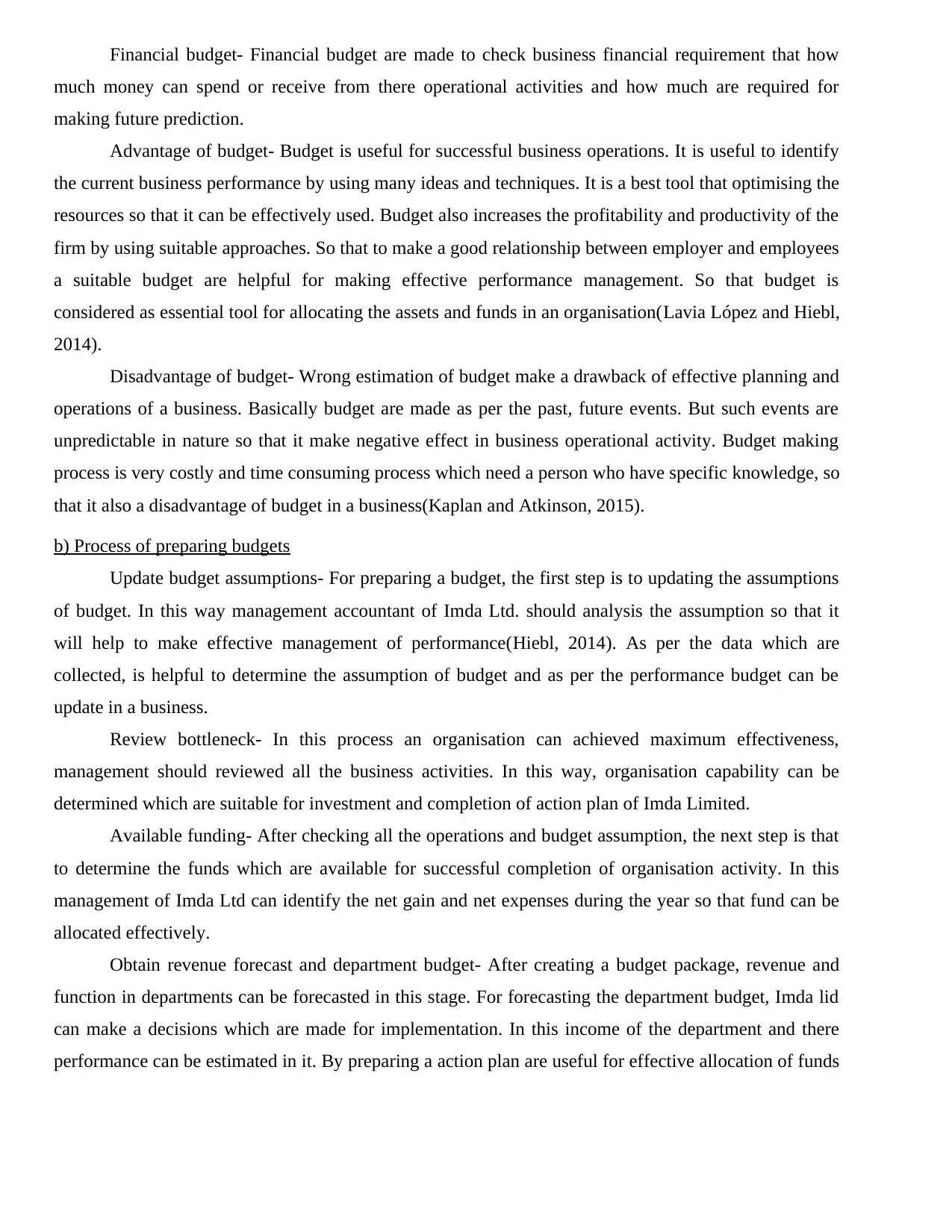
Financial budget- Financial budget are made to check business financial requirement that how
much money can spend or receive from there operational activities and how much are required for
making future prediction.
Advantage of budget- Budget is useful for successful business operations. It is useful to identify
the current business performance by using many ideas and techniques. It is a best tool that optimising the
resources so that it can be effectively used. Budget also increases the profitability and productivity of the
firm by using suitable approaches. So that to make a good relationship between employer and employees
a suitable budget are helpful for making effective performance management. So that budget is
considered as essential tool for allocating the assets and funds in an organisation(Lavia López and Hiebl,
2014).
Disadvantage of budget- Wrong estimation of budget make a drawback of effective planning and
operations of a business. Basically budget are made as per the past, future events. But such events are
unpredictable in nature so that it make negative effect in business operational activity. Budget making
process is very costly and time consuming process which need a person who have specific knowledge, so
that it also a disadvantage of budget in a business(Kaplan and Atkinson, 2015).
b) Process of preparing budgets
Update budget assumptions- For preparing a budget, the first step is to updating the assumptions
of budget. In this way management accountant of Imda Ltd. should analysis the assumption so that it
will help to make effective management of performance(Hiebl, 2014). As per the data which are
collected, is helpful to determine the assumption of budget and as per the performance budget can be
update in a business.
Review bottleneck- In this process an organisation can achieved maximum effectiveness,
management should reviewed all the business activities. In this way, organisation capability can be
determined which are suitable for investment and completion of action plan of Imda Limited.
Available funding- After checking all the operations and budget assumption, the next step is that
to determine the funds which are available for successful completion of organisation activity. In this
management of Imda Ltd can identify the net gain and net expenses during the year so that fund can be
allocated effectively.
Obtain revenue forecast and department budget- After creating a budget package, revenue and
function in departments can be forecasted in this stage. For forecasting the department budget, Imda lid
can make a decisions which are made for implementation. In this income of the department and there
performance can be estimated in it. By preparing a action plan are useful for effective allocation of funds
much money can spend or receive from there operational activities and how much are required for
making future prediction.
Advantage of budget- Budget is useful for successful business operations. It is useful to identify
the current business performance by using many ideas and techniques. It is a best tool that optimising the
resources so that it can be effectively used. Budget also increases the profitability and productivity of the
firm by using suitable approaches. So that to make a good relationship between employer and employees
a suitable budget are helpful for making effective performance management. So that budget is
considered as essential tool for allocating the assets and funds in an organisation(Lavia López and Hiebl,
2014).
Disadvantage of budget- Wrong estimation of budget make a drawback of effective planning and
operations of a business. Basically budget are made as per the past, future events. But such events are
unpredictable in nature so that it make negative effect in business operational activity. Budget making
process is very costly and time consuming process which need a person who have specific knowledge, so
that it also a disadvantage of budget in a business(Kaplan and Atkinson, 2015).
b) Process of preparing budgets
Update budget assumptions- For preparing a budget, the first step is to updating the assumptions
of budget. In this way management accountant of Imda Ltd. should analysis the assumption so that it
will help to make effective management of performance(Hiebl, 2014). As per the data which are
collected, is helpful to determine the assumption of budget and as per the performance budget can be
update in a business.
Review bottleneck- In this process an organisation can achieved maximum effectiveness,
management should reviewed all the business activities. In this way, organisation capability can be
determined which are suitable for investment and completion of action plan of Imda Limited.
Available funding- After checking all the operations and budget assumption, the next step is that
to determine the funds which are available for successful completion of organisation activity. In this
management of Imda Ltd can identify the net gain and net expenses during the year so that fund can be
allocated effectively.
Obtain revenue forecast and department budget- After creating a budget package, revenue and
function in departments can be forecasted in this stage. For forecasting the department budget, Imda lid
can make a decisions which are made for implementation. In this income of the department and there
performance can be estimated in it. By preparing a action plan are useful for effective allocation of funds
⊘ This is a preview!⊘
Do you want full access?
Subscribe today to unlock all pages.

Trusted by 1+ million students worldwide
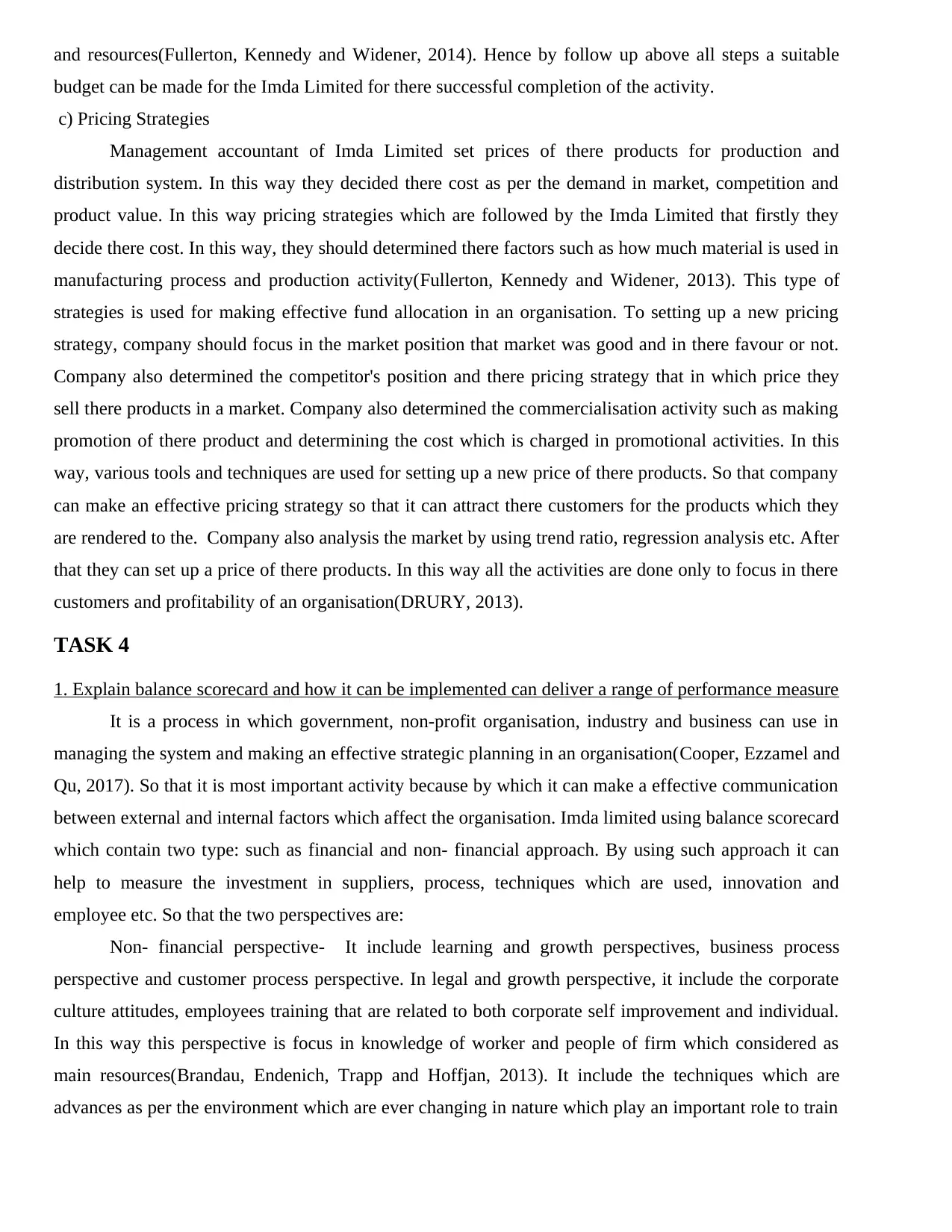
and resources(Fullerton, Kennedy and Widener, 2014). Hence by follow up above all steps a suitable
budget can be made for the Imda Limited for there successful completion of the activity.
c) Pricing Strategies
Management accountant of Imda Limited set prices of there products for production and
distribution system. In this way they decided there cost as per the demand in market, competition and
product value. In this way pricing strategies which are followed by the Imda Limited that firstly they
decide there cost. In this way, they should determined there factors such as how much material is used in
manufacturing process and production activity(Fullerton, Kennedy and Widener, 2013). This type of
strategies is used for making effective fund allocation in an organisation. To setting up a new pricing
strategy, company should focus in the market position that market was good and in there favour or not.
Company also determined the competitor's position and there pricing strategy that in which price they
sell there products in a market. Company also determined the commercialisation activity such as making
promotion of there product and determining the cost which is charged in promotional activities. In this
way, various tools and techniques are used for setting up a new price of there products. So that company
can make an effective pricing strategy so that it can attract there customers for the products which they
are rendered to the. Company also analysis the market by using trend ratio, regression analysis etc. After
that they can set up a price of there products. In this way all the activities are done only to focus in there
customers and profitability of an organisation(DRURY, 2013).
TASK 4
1. Explain balance scorecard and how it can be implemented can deliver a range of performance measure
It is a process in which government, non-profit organisation, industry and business can use in
managing the system and making an effective strategic planning in an organisation(Cooper, Ezzamel and
Qu, 2017). So that it is most important activity because by which it can make a effective communication
between external and internal factors which affect the organisation. Imda limited using balance scorecard
which contain two type: such as financial and non- financial approach. By using such approach it can
help to measure the investment in suppliers, process, techniques which are used, innovation and
employee etc. So that the two perspectives are:
Non- financial perspective- It include learning and growth perspectives, business process
perspective and customer process perspective. In legal and growth perspective, it include the corporate
culture attitudes, employees training that are related to both corporate self improvement and individual.
In this way this perspective is focus in knowledge of worker and people of firm which considered as
main resources(Brandau, Endenich, Trapp and Hoffjan, 2013). It include the techniques which are
advances as per the environment which are ever changing in nature which play an important role to train
budget can be made for the Imda Limited for there successful completion of the activity.
c) Pricing Strategies
Management accountant of Imda Limited set prices of there products for production and
distribution system. In this way they decided there cost as per the demand in market, competition and
product value. In this way pricing strategies which are followed by the Imda Limited that firstly they
decide there cost. In this way, they should determined there factors such as how much material is used in
manufacturing process and production activity(Fullerton, Kennedy and Widener, 2013). This type of
strategies is used for making effective fund allocation in an organisation. To setting up a new pricing
strategy, company should focus in the market position that market was good and in there favour or not.
Company also determined the competitor's position and there pricing strategy that in which price they
sell there products in a market. Company also determined the commercialisation activity such as making
promotion of there product and determining the cost which is charged in promotional activities. In this
way, various tools and techniques are used for setting up a new price of there products. So that company
can make an effective pricing strategy so that it can attract there customers for the products which they
are rendered to the. Company also analysis the market by using trend ratio, regression analysis etc. After
that they can set up a price of there products. In this way all the activities are done only to focus in there
customers and profitability of an organisation(DRURY, 2013).
TASK 4
1. Explain balance scorecard and how it can be implemented can deliver a range of performance measure
It is a process in which government, non-profit organisation, industry and business can use in
managing the system and making an effective strategic planning in an organisation(Cooper, Ezzamel and
Qu, 2017). So that it is most important activity because by which it can make a effective communication
between external and internal factors which affect the organisation. Imda limited using balance scorecard
which contain two type: such as financial and non- financial approach. By using such approach it can
help to measure the investment in suppliers, process, techniques which are used, innovation and
employee etc. So that the two perspectives are:
Non- financial perspective- It include learning and growth perspectives, business process
perspective and customer process perspective. In legal and growth perspective, it include the corporate
culture attitudes, employees training that are related to both corporate self improvement and individual.
In this way this perspective is focus in knowledge of worker and people of firm which considered as
main resources(Brandau, Endenich, Trapp and Hoffjan, 2013). It include the techniques which are
advances as per the environment which are ever changing in nature which play an important role to train
Paraphrase This Document
Need a fresh take? Get an instant paraphrase of this document with our AI Paraphraser

there employees as per the new techniques. So that it can describes that knowledge is more important
and necessary for the success of the business. But in business- perspective, it is also known as internal
business perspective and it help the organisation to running effectively. It also refers that the customers
are satisfied with there products or services. So that in this , all those person are focused in it which have
there unique mission. In customer process perspective, it is basically focus on customer and there
satisfaction which was provided by the different organisation. In this way, if a customers is not satisfied
properly, than organisation has shift to there another suppliers so that they can easily meet there needs in
an effective manner. So that if a company can perform poorly than there is a decline in the future, if the
company have goof financial position.
Financial perspective- In this type of perspective, company have to maintained there funds
because it is main issue which are faced by the finance mangers. So that financial perspective that are
major includes into it is cost- benefit data and risk assessment(Bodie, 2013).
CONCLUSION
The report is concluded that management accounting is an approach of organization by which
general business transaction get managed. Therefore, different management accounting tools are
determined for allocating fund for Imda limited. Including this, costing such as absorption and marginal
is considered for preparing income statement that presents financial position of organization. Moreover,
critical evaluation on budget is presented for forecasting and decision making for further business
operations. In accordance to this, several kinds of budget and its preparation process is considered
through this assignment. However, pricing strategies for setting costs according to different determinants
are described for cost effectiveness as well proper management of entity is recognized. Apart from this,
financial statement analysis is obtained by which current business performance is analysed that is
effective to reduce economic problems occur at workplace. Including this, significance of management
accounting is expressed which is used to improve governance and developing effective strategies at high
level. Thus, through this study, different management accounting tools and systems are presented for
effectiveness of entity and enhancing its financial performance systematically(Armstrong, 2014).
and necessary for the success of the business. But in business- perspective, it is also known as internal
business perspective and it help the organisation to running effectively. It also refers that the customers
are satisfied with there products or services. So that in this , all those person are focused in it which have
there unique mission. In customer process perspective, it is basically focus on customer and there
satisfaction which was provided by the different organisation. In this way, if a customers is not satisfied
properly, than organisation has shift to there another suppliers so that they can easily meet there needs in
an effective manner. So that if a company can perform poorly than there is a decline in the future, if the
company have goof financial position.
Financial perspective- In this type of perspective, company have to maintained there funds
because it is main issue which are faced by the finance mangers. So that financial perspective that are
major includes into it is cost- benefit data and risk assessment(Bodie, 2013).
CONCLUSION
The report is concluded that management accounting is an approach of organization by which
general business transaction get managed. Therefore, different management accounting tools are
determined for allocating fund for Imda limited. Including this, costing such as absorption and marginal
is considered for preparing income statement that presents financial position of organization. Moreover,
critical evaluation on budget is presented for forecasting and decision making for further business
operations. In accordance to this, several kinds of budget and its preparation process is considered
through this assignment. However, pricing strategies for setting costs according to different determinants
are described for cost effectiveness as well proper management of entity is recognized. Apart from this,
financial statement analysis is obtained by which current business performance is analysed that is
effective to reduce economic problems occur at workplace. Including this, significance of management
accounting is expressed which is used to improve governance and developing effective strategies at high
level. Thus, through this study, different management accounting tools and systems are presented for
effectiveness of entity and enhancing its financial performance systematically(Armstrong, 2014).

REFERENCES
Journals and Books
Armstrong, P., 2014. Limits and possibilities for HRM in an age of management accountancy. New
Perspectives On Human Resource Management op. cit. at, pp.154-166.
Bodie, Z., 2013. Investments. McGraw-Hill.
Brandau, M., Endenich, C., Trapp, R. and Hoffjan, A., 2013. Institutional drivers of conformity–
Evidence for management accounting from Brazil and Germany. International Business Review.
22(2). pp.466-479.
Cooper, D. J., Ezzamel, M. and Qu, S. Q., 2017. Popularizing a management accounting idea: The case
of the balanced scorecard. Contemporary Accounting Research.
DRURY, C. M., 2013. Management and cost accounting. Springer.
Fullerton, R. R., Kennedy, F. A. and Widener, S. K., 2013. Management accounting and control
practices in a lean manufacturing environment. Accounting, Organizations and Society. 38(1).
pp.50-71.
Fullerton, R. R., Kennedy, F. A. and Widener, S. K., 2014. Lean manufacturing and firm performance:
The incremental contribution of lean management accounting practices. Journal of Operations
Management. 32(7). pp.414-428.
Hiebl, M. R., 2014. Upper echelons theory in management accounting and control research. Journal of
Management Control,.24(3). pp.223-240.
Kaplan, R. S. and Atkinson, A. A., 2015. Advanced management accounting. PHI Learning.
Lavia López, O. and Hiebl, M. R., 2014. Management accounting in small and medium-sized
enterprises: current knowledge and avenues for further research. Journal of Management
Accounting Research. 27(1). pp.81-119.
Morales, J. and Lambert, C., 2013. Dirty work and the construction of identity. An ethnographic study of
management accounting practices. Accounting, Organizations and Society. 38(3). pp.228-244.
Otley, D. and Emmanuel, K. M. C., 2013. Readings in accounting for management control. Springer.
Renz, D. O., 2016. The Jossey-Bass handbook of nonprofit leadership and management. John Wiley &
Sons.
Journals and Books
Armstrong, P., 2014. Limits and possibilities for HRM in an age of management accountancy. New
Perspectives On Human Resource Management op. cit. at, pp.154-166.
Bodie, Z., 2013. Investments. McGraw-Hill.
Brandau, M., Endenich, C., Trapp, R. and Hoffjan, A., 2013. Institutional drivers of conformity–
Evidence for management accounting from Brazil and Germany. International Business Review.
22(2). pp.466-479.
Cooper, D. J., Ezzamel, M. and Qu, S. Q., 2017. Popularizing a management accounting idea: The case
of the balanced scorecard. Contemporary Accounting Research.
DRURY, C. M., 2013. Management and cost accounting. Springer.
Fullerton, R. R., Kennedy, F. A. and Widener, S. K., 2013. Management accounting and control
practices in a lean manufacturing environment. Accounting, Organizations and Society. 38(1).
pp.50-71.
Fullerton, R. R., Kennedy, F. A. and Widener, S. K., 2014. Lean manufacturing and firm performance:
The incremental contribution of lean management accounting practices. Journal of Operations
Management. 32(7). pp.414-428.
Hiebl, M. R., 2014. Upper echelons theory in management accounting and control research. Journal of
Management Control,.24(3). pp.223-240.
Kaplan, R. S. and Atkinson, A. A., 2015. Advanced management accounting. PHI Learning.
Lavia López, O. and Hiebl, M. R., 2014. Management accounting in small and medium-sized
enterprises: current knowledge and avenues for further research. Journal of Management
Accounting Research. 27(1). pp.81-119.
Morales, J. and Lambert, C., 2013. Dirty work and the construction of identity. An ethnographic study of
management accounting practices. Accounting, Organizations and Society. 38(3). pp.228-244.
Otley, D. and Emmanuel, K. M. C., 2013. Readings in accounting for management control. Springer.
Renz, D. O., 2016. The Jossey-Bass handbook of nonprofit leadership and management. John Wiley &
Sons.
⊘ This is a preview!⊘
Do you want full access?
Subscribe today to unlock all pages.

Trusted by 1+ million students worldwide
1 out of 13
Related Documents
Your All-in-One AI-Powered Toolkit for Academic Success.
+13062052269
info@desklib.com
Available 24*7 on WhatsApp / Email
![[object Object]](/_next/static/media/star-bottom.7253800d.svg)
Unlock your academic potential
Copyright © 2020–2025 A2Z Services. All Rights Reserved. Developed and managed by ZUCOL.





